

|
 |
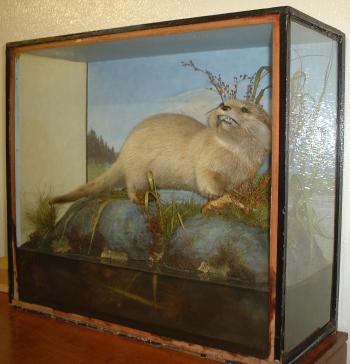
ORDER CARNIVORA
FAMILY MUSTELIDAE
WEASEL FAMILY
General features and members of the family
The weasel family is one of five families of dog-like mammals descended from the wolf-like Vulperines and comprises five sub-families of 55 species in 24 genera:
- Subfamily Mustelinae: weasels, stoats, mink, polecats, martens, wolverines;
- Subfamily Lutrinae: otters;
- Subfamilies Melinae, Taxidiinae, Mellivorinnae: badgers.
Mustelids are typically long thin-bodied animals and spend most of their time hunting for food to sustain their high metabolic rates. They are highly active foragers that pursue their prey relentlessly. Several mustelids are agile climbers and can snatch birds and squirrels from their nests. Otters are aquatic. The smallest is the Least Weasel (20 - 25 cm long; 30 - 70g in weight); the largest is the Giant Otter (1.5 - 2 m long; 30 kg in weight). The Least Weasel is the smallest member of the Carnivora.
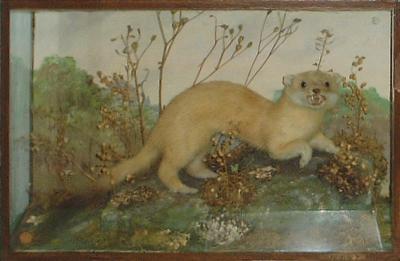 | General features of mustelids, depicted by stoat |
Mustelids are widespread being absent only from Australia and Antartica. They are not indigenous to New Zealand but stoats have been introduced and they now pose a serious threat to the native wildlife. Most of the wild British Carnivorans are mustelids.
At least 16 species have developed a remarkable reproductive strategy of delayed implantation where, following fertilisation, the embryo does not implant in the uterus wall until certain external environmental conditions are met. This delay can last up to ten months and often only occurs through the winter period. It occurs in solitary Mustelids, which only tolerate the opposite gender for a relatively short mating period.
Skulls, dentition and diet
Most members of the subfamily Mustelinae have a dental formula of I3/3, I 1/1, PM3/3, M1/2 = 34 with prominent, sharp canines and cutting carnassials. The dentition of members of other subfamilies differs slightly from this arrangement. The carnassial teeth are modified to some degree in all. The smaller mustelids feed mainly on burrow-dwelling mice voles and rabbits while larger mustelids have specialised diets according to the prey found in their particular habitats.
Subfamily Mustelinae: weasels, stoats, mink, polecats, martens, wolverines.
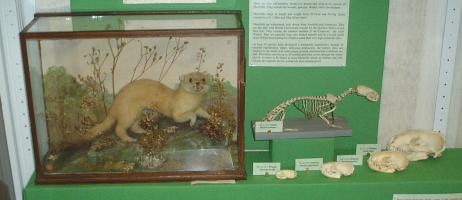
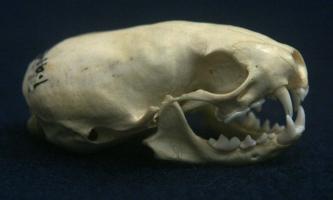 |
Weasel skull (Dental formula: I3/3, I 1/1, PM3/3, M1/2 = 34).
The Least or European common weasel (Mustela nivalis) is a small rodent specialist but also feeds on birds, eggs and young lagomorphs (hares). This weasel is the smallest carnivore; it is small enough to follow field voles and lemmings in their runways in thick grass and under snow. These weasels can coexist with stoats because they take smaller prey than the larger stoats. |
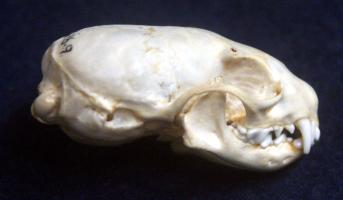 |
Stoat skull.
The stoat or ermine (Mustela erminea) feeds on small mammals such as rabbits and water voles as well as birds, earthworms and berries. The stoat is noted for its winter coat of white with a black tip to its tail which serves to camouflage it in the snow. |
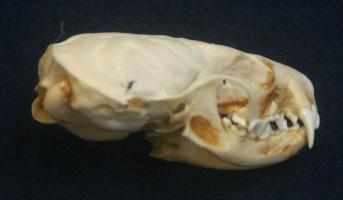 |
American mink skull
The American mink (Mustela vison) feeds on mammals (rodents, rabbits), fish,and aquatic birds (ducks, moorhens, coots, gulls) and invertebrates. |
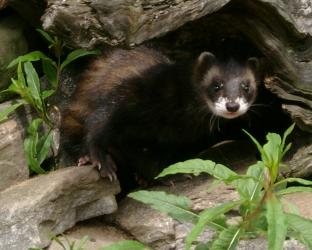 | 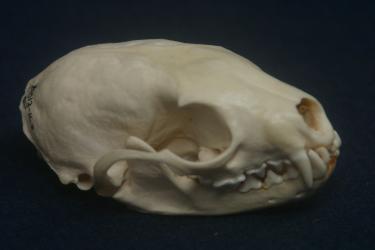 |
| European polecat | European polecat skull |
| The polecat (Mustela putorius) feeds on lagomorphs, small rodents, birds, and amphibians (frogs, toads). |
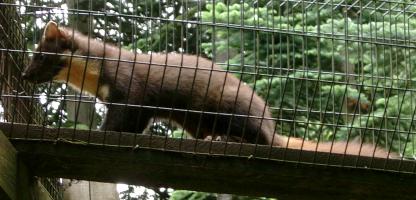 | 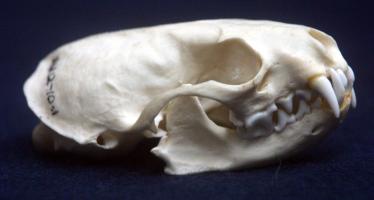 |
| Pine Marten | Pine marten skull (Dental formula: I3/3, I 1/1, PM4/4, M1/2 = 38). |
| The pine marten (Martes martes) forages both in trees and on the ground feeding on small rodents, rabbits squirrels birds, beetles and berries. |
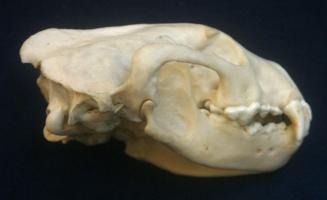 |
Wolverine skull (Dental formula: I3/3, I 1/1, PM4/4, M1/2 = 38).
The wolverine (Gulo gulo) lives in alpine tundra and taiga habitats in the circumpolar regions of North America and Eurasia. It is the largest member of the subfamily Mustelinae, with a powerful build that allows it to tackle prey many times its own size. Wolverines feed on rodents, birds such as ptarmigan, eggs, invertebrates, fruit, berries and carrion. It will also kill elk, reindeer, foxes, roe deer and wild sheep when their movement is hindered by snow. Their heavy premolars and powerful jaws can crush bone and gnaw frozen meat. |
Subfamily Lutrinae: otters.
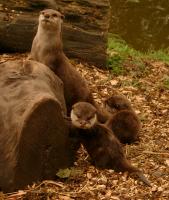 | 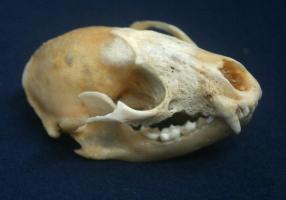 |
| Oriental small-clawed otters | Eurasian otter skull (Dental formula: I3/3, I 1/1, PM4/3 - 4, M1/2 = 36 - 38). |
| Otters are the only amphibious mustelids. They forage mainly in water but spend much time resting on shore except for the sea otter, which rarely comes ashore. Eurasian otters (Lutra lutra), living in freshwater habitats, feed on fish, as well as crayfish, frogs, waterfowl and birds roosting in reeds; coastal otters also eat crustaceans. Otters are adapt to swim with elongated and lithe bodies, tapering flat tails, short legs, webbed and clawed feet, small round ears which, like their nostrils, close when under water. Their long guard hairs and dense under-fur trap air and insulate them while they are underwater. The numerous stiff whiskers (vibrissae) on the snout detect their prey. |
Subfamily Melinae: badgers.
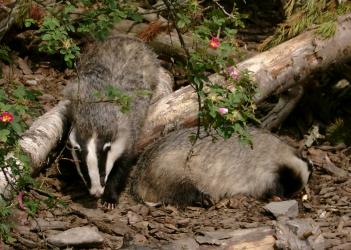 | 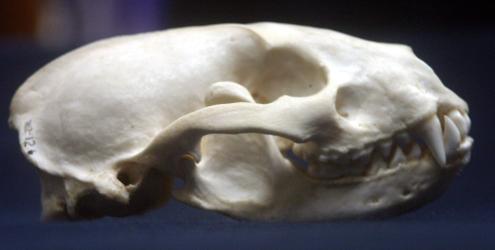 |
| Eurasian badgers | Eurasian badger skull (Dental formula: I3/3, I 1/1, PM4/4, M1/2 = 38).
| | The Eurasian badger (Meles meles) has a very varied diet. In Britain, it feeds almost exclusively on earthworms and plant roots. However it will also consume other invertebrates (molluscs, beetles and other insects e.g. caterpillars, wasp nests, bumble bee nests), vertebrates (amphibians, reptiles and small, especially young, mammals e.g. rabbits, mice, voles, moles), carrion and cereals, fruit, tubers, corms, clover and grass. |
| Dog-like carnivorans |
Aquatic carnivorans |
Cat-like carnivorans |
|---|
|
|
|
|
|






















